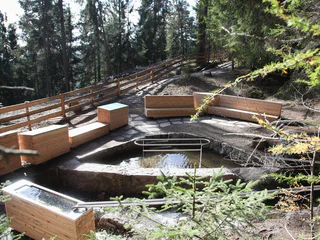
Alpine Pasture Trail in Ratschings/Racines
Valgiovo/Jaufental, Ratschings/Racines, Sterzing/Vipiteno and environs
Všude v prázdninových regionech Jižního Tyrolska jsou vyznačeny tematické procházky, speciální objevitelské trasy pro malé i velké. Například v jihotyrolském Unterlandu mohou návštěvníci na podzim zažít, jak se hrozny dostanou z vinné révy do sudu. V San Valentinu v Campo/Gummeru můžete prozkoumat vesmír a naši sluneční soustavu a v Terlanu/Terlanu pěstitelé chřestu předvedou, jak se na jaře získává ze země vzácný chřest. Celkem na návštěvníky Jižního Tyrolska čeká více než 150 značených a poučných tematických procházek.

Valgiovo/Jaufental, Ratschings/Racines, Sterzing/Vipiteno and environs

Novale/Ried, Lajen/Laion

Soprabolzano/Oberbozen, Ritten/Renon, Bolzano/Bozen and environs

S. Pietro/St. Peter - Valle Aurina/Ahrntal, Ahrntal/Valle Aurina, Ahrntal/Valle Aurina

1/2
Auna di Sopra/Oberinn, Ritten/Renon, Bolzano/Bozen and environs

1/3
Monte di Tramontana/Nördersberg, Schlanders/Silandro, Vinschgau/Val Venosta

Ega/Eggen, Deutschnofen/Nova Ponente, Dolomites Region Eggental

1/3
Soprabolzano/Oberbozen, Ritten/Renon, Bolzano/Bozen and environs

1/4
Vallesina/Versein, Mölten/Meltina, Bolzano/Bozen and environs

1/7
Ora/Auer, Auer/Ora, Alto Adige Wine Road

Nove Case/Neunhäusern, Rasen-Antholz/Rasun Anterselva, Dolomites Region Kronplatz/Plan de Corones

S. Maddalena/St. Magdalena - Casies/Gsies, Gsies/Valle di Casies

Radein/Redagno, Aldein/Aldino

1/2
Stanghe/Stange, Ratschings/Racines, Sterzing/Vipiteno and environs

1/8
Longiarù/Campill, San Martin /San Martino, Dolomites Region Kronplatz/Plan de Corones

1/4
Certosa/Karthaus, Schnals/Senales, Vinschgau/Val Venosta

Solda/Sulden, Stilfs/Stelvio, Vinschgau/Val Venosta

1/4
Plata/Platt, Moos in Passeier/Moso in Passiria, Meran/Merano and environs

1/4
Caines/Kuens, Tirol/Tirolo, Meran/Merano and environs

Pochi/Buchholz, Salorno/Salurn, Alto Adige Wine Road

Plata/Platten - Falzes/Pfalzen, Pfalzen/Falzes, Dolomites Region Kronplatz/Plan de Corones

Acereto/Ahornach, Sand in Taufers/Campo Tures, Ahrntal/Valle Aurina

1/2
Terento/Terenten, Terenten/Terento, Brixen/Bressanone and environs

1/5
San Felice/St. Felix, U.L.Frau i.W.-St. Felix/Senale-S.Felice, Meran/Merano and environs

1/3
San Vigilio, Al Plan/San Vigilio, Dolomites Region Kronplatz/Plan de Corones

1/2
Pescosta/Pescosta, Sëlva/Selva di Val Gardena, Dolomites Region Val Gardena

Montassilone/Tesselberg, Gais, Dolomites Region Kronplatz/Plan de Corones

1/7
Laghetti/Laag, Neumarkt/Egna, Alto Adige Wine Road

1/5
Tubre/Taufers i. M., Mals/Malles, Vinschgau/Val Venosta

Ridnaun/Ridanna, Ratschings/Racines, Sterzing/Vipiteno and environs